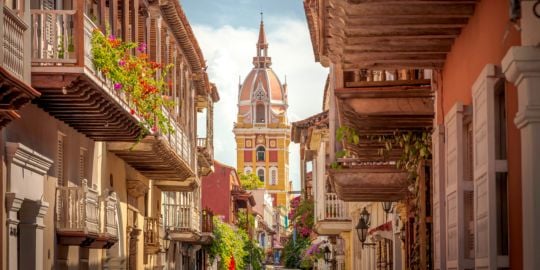Hello everyone,
Which city or area do you live in in Colombia, and how do you find the traffic?
How long does it take to commute to work or run errands?
Is there a rush hour in your city? What times of the day would you recommend people to avoid driving if they can?
Are there any ways to avoid spending too much time in traffic in Colombia?
What is parking availability and cost like?
Thank you for sharing your experience.
Priscilla
Traffic in Colombia
Avoiding traffic...
1. Stay off the road during rush hour if possible in larger cities.
2. Use WAZE or other GPS/traffic ap to guide your driving movements.
3. Avoid the rush on holiday weekends if possible.
4. Learn short cuts where available using online maps.
5. Drive in nighttime-safe areas instead of daytime driving on weekdays.
6. Plan driving on non-holiday weekends, instead of weekdays, to avoid congestion.
7. Avoid stadiums and other sports venues on major game days.
8. Get good at learning the ins and outs of one-way streets in your city .. and how to make a U-turn or equivalent on major roads where left-hand turns and U-turns are prohibited at most corners.
-- cccmedia in Depto. de Nariño
I've lived here in Colombia for over 11 years now and I love it here. However, I have to say the drivers here are the very worst I've ever seen and I've been to many countries.
The worst are the motorcycle drivers. They weave in and out of traffic. They pass you on the right and left and cut in front of you, as if to dare you to hit them. Often, they will pass you on one side and immediately turn the other direction, causing you to brake hard or swerve to miss them. More than one rider has been killed by a driver, who had to swerve or brake hard to miss another rider. They will even pass you on the left, when there is lots of oncoming traffic, expecting you to move over, so they don't get hit. If you don't, you'll at least get a dirty look and likely "the finger".
Car drivers have a habit of passing on blind curves and, of course, there have been deadly accidents as a result.
Colombians are wonderful, friendly and, helpful people, until they get behind the wheel or on a motorcycle (moto).
The heaviest traffic times are from about 7 AM to 9 AM and 3 PM to 6 PM, in the Rionegro (San Nikolas valley). In Medellin, it's heavy traffic from about 6 AM until about 9 PM... Yes, basically all day. Medellin has driving restrictions, called "Pico de Placa", which restricts cars with license plate numbers ending with "the number of the day". I think now it's actually four numbers every day, that are restricted. I forget the exact hours but, it's basically the hours I mentioned above. I don't drive in Medellin at all so, I'm not up on the details. Actually, because of the motos, I gave up driving at all about two years ago. That's now my wifes job. I bought an SUV, that's basically a tank with four wheels, instead of tracks, to give her as much protection as possible. She's had several accidents with motos. Fortunately, no one had died... yet.
If you plan to drive in Colombia, be very careful and constantly check in your side mirrors for motos.
laceja, agree with you to let your wife drive. I will not drive in Colombia, but I will drive my little moped here in Rionegro. But it's mainly used to take my wife to and from work, because I refuse to pay 15.000 COP for her to park at the hospital everyday for work.
My wife does all of the driving to Medellin. I have to remind her that the car is not made for racing.
Just in case you may need it if driving and traveling to different cities in Colombia, here is Pico y Placa information for all the major cities on one site:
http://www.picoyplaca.info/
1. I live in Bogotá and the traffic is TERRIBLE, not only that but drivers tend to be bad at using directional signals and the motorcyclists are the WROST they weave around cars.
2. I hate driving in Bogotá and LUCKLY I live near my work so I bike or sometimes walk to my work
when ever I can. That takes me 10 mins to arrive at most. Biking is an amazing alternative for this city. There are also around 200km of bike lanes and a big bike culture in the city.
3. Rush hour in the morning is around 6.30am to 8.30am and at night i would say 6pm to 7.30pm these times the traffic is unbearable.
4. Ways to avoid traffic for me would be living near work if you can. If not I would suggest biking or using a bike sharing system like MUVO. ( www.muvo.bike) This is an electrical bike system that you can use with an app to find bikes near you and rent them from station to station. They just have a few docks for now in cityparking parking lots, but I understand the company is slowly growing.
living in bogota and traffic is pretty bad... present mayor has made things a little easier (about 10 minutes less traffic), but still...
walking is great and it works well. bicycles, more or less...
best solution: try and live near your job. whenever you want to do some errand, avoid rush hours. if you want to go for some holiday outside the city, go by car (or plane), and try to use very early hours...
still, bogota is a great city!! trust me...
marcelobulk wrote:living in bogota and traffic is pretty bad... present mayor has made things a little easier (about 10 minutes less traffic).
How did the mayor of Bogotá reduce traffic by 10 minutes?
And does that mean your personal commute on weekday mornings takes 10 fewer minutes?
cccmedia
yes, it takes an average of less than 10 minutes - for the airport, 20 minutes less...
he fixes some routes, he increased security in our mass transportation - which created a certain sense of security and a few people went back to use it, instead of cabs...
he also finalised many constructions that started in the form government, and that sped up things a bit...
it is still very bad, but a little better...
Hi Everyone,
I've been living in Bogota for about 7 months now and loving it. I don't drive much; only on the occasions my wife is tired and needs a break. I don't really like driving here a whole lot for the same reasons mentioned by everyone else; the motos! They're horrible and I find I try to drive close to one side of the lane to force them to only pass me on one side. (doesn't always work lol)
Im still studying Spanish and have a private teacher that comes to my apartment. As well as this I am setting up a new online business; so I only really go out for a break from the apartment or to buy cosas.
Rush hour here is 6-9am and 4:30-8:30pm. Avoid these times if you can. But in reality, I find everything takes a bit longer here than elsewhere. So if I happen to be driving during these times I just accept it and always take a sandwich ;-)
I've spent time in Cali and Bogota. I've driven in the US for over 40 years. I will not drive in Colombia. The traffic is awful, in my opinion, correction: the traffic is just awful. Taxis are cheap so I take taxis or maybe I would use Uber.
Given that the traffic in Cali and Medellín is bad news, Expats for whom this is a dealbreaking-issue should consider small to medium sized cities.
This year, 2017, I have spent months with my (Ecuadorian-plated) car during stays in Armenia, Quindío, and Ipiales, Nariño .. and the traffic has been moving and easily tolerable. The moto situation is nothing like the constant darting, cut-offs and blind entrances in Cali and Medellín. Even rush-hour means only a few minutes of delays along the busier streets.
The exception is holiday-weekend traffic in Ipiales, when this border city can be overrun with Ecuadorian tourists on shopping sprees, especially from downtown to the big mall on Carrera 7.
cccmedia in Ipiales
For me taxis are a good solution. Taxis are cheap in Colombia and I probably pay less than the cost of owning and operating a car, plus I don't need a parking space. The downside is that most taxis in Colombia are tin-cans with wheels. It's rare to find seat belts that aren't buried in the back seat so you are basically in a roller-coaster without the ups and downs.
The problems with relying on taxis in some cities in Colombia...
1. Can be difficult to find a taxi when it's raining.
2. Difficult to find one late at night. Then you may be stuck with unofficial "gypsy" taxis, not known for safety. If you must ride with a gypsy, make sure it's one who is a known quantity to the restaurant, business or friends where you have been visiting.
3. Only 20 percent of big-city taxis have air conditioning. May not be a problem in chilly Bogotá.
4. Some drivers do not like to wait if you need to make a second or third stop on one trip.
5. The constant struggle to get drivers to turn down the music-radio. If he has a second radio (communicating with dispatch), he won't turn it off as a rule .. and the squawking and loud noises emanating from the device may be never-ending till you arrive at your destination.
cccmedia in Ipiales, Nariño
And the constant cell=phone chatter - hand held to ear, one hand on the wheel.
Which are the worst countries to drive in and contrarily the best? I have been to Colombia 5 times and Ecuador once and Brazil once, and just got back from my 5th trip to Nicaragua, but I have never driven in any of these countries.....ONly buses and taxis.....I have only driven en Panama and Costa Rica but for many years, and have had numerous close calls and seen horrible bloody accidents quite a few times.........So you never really know a country until you drive there........So out of all these latin countries where is the most dangerous and the most reasonable place to own and operate a car? Becuz Im looking for an alternative to Panama..........
I have driven in Panama and in Colombia, but rarely in a city - except for getting through David on the way to Las Olas, Driving around the surrounding neighbourhoods of Boquete, and exploring the pueblos around La Ceja in Colombia, was relatively stress-free. The challenges are in negotiating the mountain curves, but I found everyone did stick to the proper lane - which helps a lot! The closer you get to the larger community, the more the stress level climbs, principally due to the idiotic and suicidal motorcycle riders. I have even rented a moto to explore the countryside around Salento, and there is no doubt that vehicukar travel - by car or moto - is a completely different experience in the country vs the major cities.









